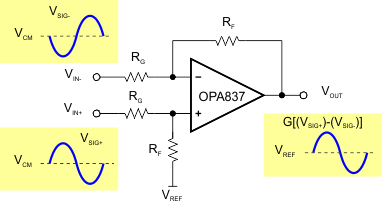ZHCSGP3D September 2017 – December 2018 OPA2837 , OPA837
PRODUCTION DATA.
- 1 特性
- 2 应用
- 3 说明
- 4 修订历史记录
- 5 Pin Configuration and Functions
-
6 Specifications
- 6.1 Absolute Maximum Ratings
- 6.2 ESD Ratings
- 6.3 Recommended Operating Conditions
- 6.4 Thermal Information: OPA837
- 6.5 Thermal Information: OPA2837
- 6.6 Electrical Characteristics: VS = 5 V
- 6.7 Electrical Characteristics: VS = 3 V
- 6.8 Typical Characteristics: VS = 5.0 V
- 6.9 Typical Characteristics: VS = 3.0 V
- 6.10 Typical Characteristics: ±2.5-V to ±1.5-V Split Supply
- 7 Detailed Description
-
8 Application and Implementation
- 8.1
Application Information
- 8.1.1 Noninverting Amplifier
- 8.1.2 Inverting Amplifier
- 8.1.3 Output DC Error Calculations
- 8.1.4 Output Noise Calculations
- 8.1.5 Instrumentation Amplifier
- 8.1.6 Attenuators
- 8.1.7 Differential to Single-Ended Amplifier
- 8.1.8 Differential-to-Differential Amplifier
- 8.1.9 Pulse Application With Single-Supply Circuit
- 8.1.10 ADC Driver Performance
- 8.2 Typical Applications
- 8.1
Application Information
- 9 Power Supply Recommendations
- 10Layout
- 11器件和文档支持
- 12机械、封装和可订购信息
8.1.7 Differential to Single-Ended Amplifier
Figure 78 shows a differential amplifier that converts differential signals to single-ended in a single stage and provides gain (or attenuation) and level shifting. This circuit can be used in applications such as a line receiver for converting a differential signal from a Cat5 cable to a single-ended output signal.
 Figure 78. Differential to Single-Ended Amplifier
Figure 78. Differential to Single-Ended Amplifier The output of the amplifier can be calculated according to Equation 9 if VIN+ = VCM + VSIG+ and VIN– = VCM + VSIG–.

The signal gain of the circuit is shown in Equation 10, VCM is rejected, and VREF provides a level shift or reference voltage around which the output signal swings. The single-ended output signal is in-phase with the noninverting input signal. VREF is often ground when split supplies are used on the op amp.

Line termination can be accomplished by adding a shunt resistor across the VIN+ and VIN– inputs. The differential impedance is the shunt resistance in parallel with the input impedance of the amplifier circuit, which is usually much higher. For low gain and low line impedance, the resistor value to add is approximately the impedance of the line. For example, if a 100-Ω Cat5 cable is used with a gain of 1 V/V amplifier and RF = RG = 2 kΩ, adding a 100-Ω shunt across the input gives a differential impedance of 99 Ω, which is an adequate match for most applications.
For best CMRR performance, resistors must be matched. Assuming CMRR ≈ the resistor tolerance, a 0.1% tolerance provides approximately 60-dB CMRR.